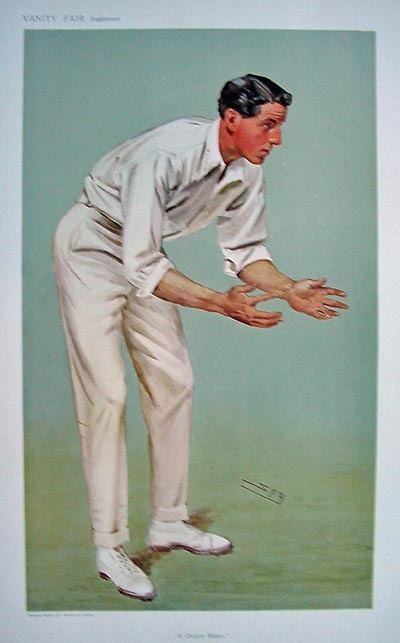Batting style Right-handed Role Cricket Player Name Kenneth Hutchings | National side England | |
 | ||
Full name Kenneth Lotherington Hutchings Died September 3, 1916, Ginchy, France | ||
Kenneth Lotherington Hutchings (7 December 1882 – 3 September 1916) was an English amateur cricketer who played for Kent County Cricket Club and the England cricket team between 1902 and 1912. He was primarily a batsman who played a major role in three of Kent's County Championship wins in the years before World War I and who played seven Test matches for England. He was chosen as one of Wisden's Cricketers of the Year in 1907. Hutchings was killed in action during the Battle of the Somme whilst serving with the King's Liverpool Regiment in 1916.
Contents
Early life
Hutchings was born in Southborough near Tunbridge Wells, the fourth son of Dr Edward Hutchings. He was educated at Tonbridge School where he played in the First XI for five years between 1898 and 1902, captaining the school in his last two years there and also playing racquets for the school. In 1902 he averaged 63 including a score of 205.
Cricket career
Hutchings made his first-class debut in 1902, playing once for Kent in the 1902 County Championship. He played fluently in 11 Championship matches in 1903 and toured America with Kent, playing against the Gentlemen of Philadelphia, but only made three appearances in total for the County in 1904 and 1905, scoring two half centuries.
His first full season for Kent in 1906 was the most productive of his career. His "ultra-attacking batting" saw him score 1,454 runs for the County at an average of 60.58, a major role in Kent winning their first County Championship title. He led the county in runs scored despite only playing in 18 games out of a possible 25 during the season. He scored four centuries and played, according to Wisden with "amazing brilliancy" whilst The Guardian described him as "the most brilliant" of Kent's batsmen in a team with very strong batting. He was picked for the Gentlemen v Players match and was chosen as one of Wisden's Cricketers of the Year in 1907.
Hutchings was picked for the England cricket team to tour Australia in 1907–08, making his Test match debut in December 1907 at Sydney. He scored his highest Test score of 126 at Melbourne on the tour, reaching his hundred in 126 minutes, his second fifty taking only 51 minutes.
Hutchings never completely recaptured his form of 1906 and Wisden wrote that he "did not fulfil all the hopes formed of him", although he scored over 1,000 first-class runs in every English domestic season between 1906 and 1911. His best seasons, other than 1906, were in 1909 and 1910 when Kent won consecutive County Championships, and he was picked for two Ashes Tests in England in 1909. His form failed him in 1912 and he was dropped from the Kent First XI in June and did not play first-class cricket of any kind after the end of the 1912 season.
Style of play
Hutchings was regarded as a hard hitting and graceful batsman. Commenting on his 1906 permanence, Wisden writes that "the consistency of his batting was not less astonishing than its brilliancy". It goes on to say that "Batting so remarkable and individual as his, has not been seen since Ranjitsinhji and Trumper first delighted the cricket world", comparing him to two great cricketers of the time, although his obituary is clear that he did not fulfil the potential that the 1906 season clearly showed.
He was considered an attacking batsman who could score all around the wicket with "a style that is entirely his own". He scored quickly when on form and was an "ideal cricketer". His cover drive was considered particularly effective and hard hitting as well as attractive - A. A. Thomson wrote of him: "Though a crabbed unemotional Northerner, I sometimes think that if one last fragment of cricket had to be preserved, as though in amber, it should be a glimpse of K. L. Hutchings cover-driving under a summer heaven." According to David Denton and George Hirst, he hit the ball harder than any other player of their time (and they were contemporaries of Gilbert Jessop, one of the harder hitting batsmen of the Golden Age of cricket).
Military service and death
Hutchings was working as a paper manufacturer in Liverpool at the start of World War I and enlisted within a few days of the start of the war. He served in the King's Liverpool Regiment and was sent to France in April 1915. He was attached to the Welch Regiment for a time and promoted to Lieutenant in December 1916. From July 1916 he served with the 12th battalion the King's Liverpool Regiment.
Hutchings was killed in action on 3 September 1916 at Ginchy in northern France during the Battle of the Somme. Hutchings was hit by an artillery shell and, according to Wisden, killed instantly. At the time of his death he was described as the most famous cricketer to have died in the Great War and the Daily Telegraph wrote that "one of the greatest cricketers has been taken from us". His name appears on the Thiepval Memorial.
All three of his brothers served in the war, all being wounded or injured in the process. Two of his brothers, William and Frederick also played first-class cricket for Kent.
